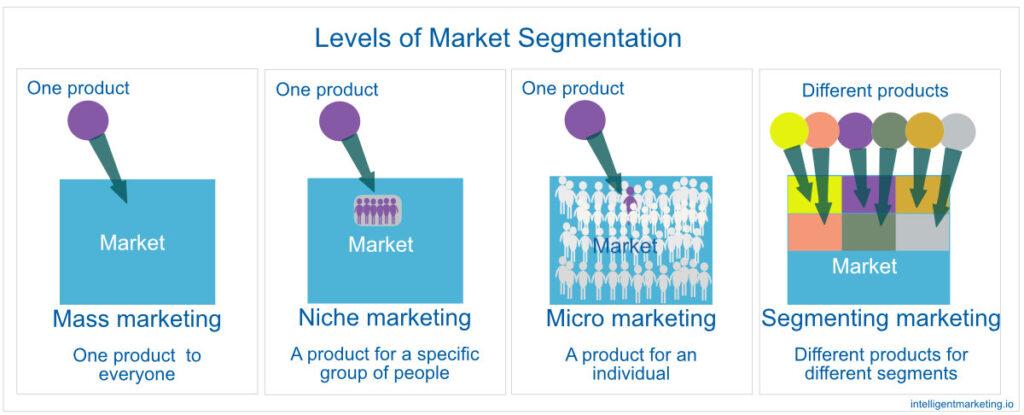As a business owner or marketing professional, it’s important to understand market segmentation and how to go about dividing up your customer base for greater success. There are many different ways to segment a market, but the most common methods are by geographic location, demographics, psychographics, and behavior. In this blog post, we’ll take a closer look at each of these methods and discuss the pros and cons of each.
Geographic Segmentation
Geographic segmentation is one of the most commonly used methods of market segmentation.
This method involves dividing up your market based on its location.
For example, you might segment your market by country, state/province, city, or even neighborhood. The advantage of this method is that it’s relatively easy to do and it can be very meaningful if your product or service is location-specific.
However, the downside is that geographic segmentation can also be quite meaningless if the preferences of customers in different geographical regions vary widely.
For example, if you sell snow tires, then geographic segmentation makes a lot of sense. But if you sell fashion items, then geographic segmentation may not be as helpful because fashion trends vary widely from one region to another.
Demographic Segmentation
Demographic segmentation is another commonly used method of market segmentation.
This method involves dividing up your market based on characteristics such as age, gender, income level, education level, etc.
The advantage of demographic segmentation is that it’s easy to do and it can provide valuable insights into who your target market is and what their needs/wants are.
The downside is that demographic information alone does not always give you a clear picture of why people buy what they buy or how they make their purchasing decisions. For this reason, demographic information is often combined with other methods of segmentation such as psycho-graphics or behavior in order to get a more accurate picture of the customer.

Psychographic Segmentation
Psychographic segmentation is a method of market segmentation that clusters customers together based on lifestyle choices and personality traits.
The advantage of this method is that it can give you very accurate insights into why people make the purchasing decisions they do.
The downside is that it requires more time and research to accurately identify customer clusters within this type of segmentation.
Behavioral Segmentation
Behavioral segmentation groups customers together based on their past buying behavior. This could include factors such as frequency of purchases, reasons for purchase (i.e., need vs want), timing of purchase (i.e., impulsive vs planned), etc.
The advantage of behavioral segmentation is that it allows you to predict future buying behavior with a high degree of accuracy.
The downside is that it can be difficult to accurately identify customer segments without having access to detailed data on past purchasing behavior.
Which Segmentation Is The Best?
Psychographic and behavioral segmentation is especially useful for creating advertising and promotion plans. Segmenting your audience by demographics and geography will help you know where to find them and how to identify them.
There is no one-size-fits-all approach. The best way to segment your market will depend on your specific product or service, your target market, and your business goals. However, by using a combination of the methods discussed above, you can get a clear picture of who your target market is and how to best reach them.
Creating a Persona
Marketers create a fictional persona to appeal to their target market. The persona is based on research including surveys, interviews, focus groups, and data. This information is used to understand the wants, needs, and problems of potential customers.
Creating a persona helps marketers better understand how to reach their target market and how to select the right auditories, for example, on Meta Ads (Facebook Ads) and Google Ads platforms. It also allows them to create more effective marketing campaigns that are tailored to the needs of their target audience.
When developing a persona, marketers should keep the following in mind:
- The persona should be based on real data from customer surveys, media data, social data, web data, point-of-sale data, Internet of Things (IoT) data, engagement data, interviews, and focus groups.
- The persona should be realistic and represent a typical member of the target market.
- The persona should be detailed enough to provide guidance for marketing campaigns.
- The persona should be revisited on a regular basis to ensure that it is still accurate and relevant.
And you need to answer some questions about your users and their needs.
- Who are your target users?
- What are their goals?
- What motivates them?
- What challenges do they face?
Once you have a good understanding of your target users, you can start developing your personas.
When creating a persona, you’ll want to give them a name, age, occupation, photo, and personality. You’ll also want to include their goals, motivations, and challenges. Once you have all of this information, you can start writing out your persona’s story.
For example:

Mark is your average target user. He’s looking for products that will help him improve his life and make it more efficient. He’s also motivated by challenges, so he’ll be more likely to engage with marketing campaigns that are challenging or require some effort on his part.
Keep your personas realistic and based on actual data from your research. This will help you create more effective marketing campaigns that are tailored to the needs of your target audience.
Creating a persona can be a helpful exercise for any business, but it is especially important for small businesses that may not have the resources to reach their entire target market. By creating a persona, small businesses can focus their efforts on the individuals who are most likely to become customers.
Levels of Market Segmentation
There are four levels of market segmentation:
- Mass marketing -this is when a business produces one product or service and sells it to everyone.
- Niche marketing -this is when a business produces a product or service for a specific group of people.
- Micro marketing -this is when a business produces a product or service for an individual.
- Segmenting marketing – this is when a business produces different products or services for different market segments.

Data for Segmentation
Because we now have an overwhelming amount of data available to us from social media, the web, point-of-sales systems, e-commerce sales, the IoT (Internet of Things), and others, segmentation has become more data-driven and more dynamic. While this is great on one hand, it presents a big challenge for many companies to integrate all these data into one data ecosystem.
This is where data management platforms (DMPs) come in. A DMP is a platform that helps companies to collect, cleanse, and normalize all their data from various sources into one central location. This allows businesses to have a 360-degree view of their customers and create more targeted marketing campaigns.
There are many different types of DMPs available in the market today. Some are better suited for small businesses while others are designed for large enterprises. The right DMP for your business will depend on your specific needs and requirements.
Here are some of the most popular data management platforms:
- Adobe Marketing Cloud: Adobe Marketing Cloud is a comprehensive suite of marketing tools that helps businesses to create, manage, and measure their marketing campaigns. It includes a DMP called Adobe Audience Manager which helps businesses to collect, segment, and target their audience.
- Oracle BlueKai: Oracle BlueKai is a cloud-based DMP that helps businesses to collect and activate customer data. It offers features such as web and app tagging, first-party data collection, cross-device tracking, and more.
- Salesforce Marketing Cloud: Salesforce Marketing Cloud is a powerful marketing platform that includes a DMP called Journey Builder. It helps businesses to create personalized customer journeys and track their progress across multiple channels.
- The Trade Desk: The Trade Desk is a self-service DMP that helps businesses to run targeted advertising campaigns. It offers features such as real-time bidding, cross-device targeting, and more.
- Lotame: Lotame is a cloud-based DMP that helps businesses to collect, segment, and activate their customer data. It offers features such as web and app tagging, first-party data collection, cross-device tracking, and more.
The right data management platform can help businesses to collect, cleanse, and normalize their data from various sources into one central location. This allows businesses to have a 360-degree view of their customers and create more targeted marketing campaigns.
Conclusion
There are many different ways to segment a market for greater success. The most common methods are by geographic location, demographics, psycho-graphics, and behavior. Each method has its own advantages and disadvantages depending on your needs and objectives. When done correctly, market segmentation can be an invaluable tool for achieving business success.
